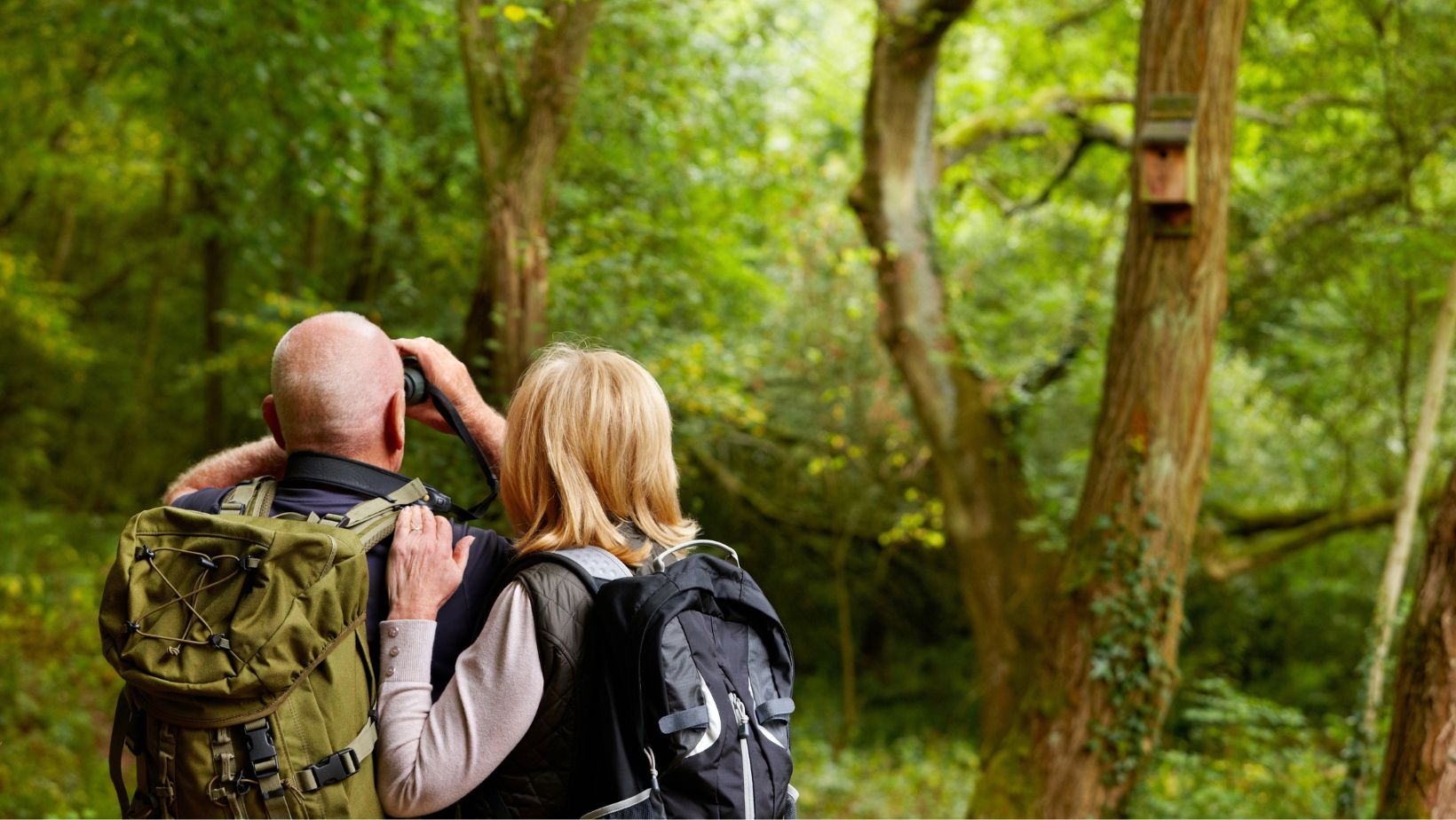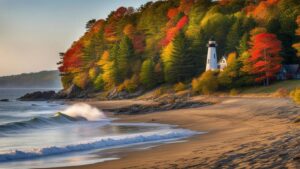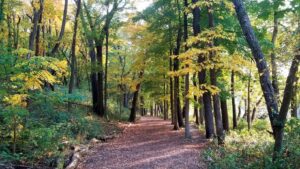
There’s something utterly peaceful about hearing the chatter of birds all around you, and Western Michigan serves as a prime bird-watching location during spring migration. You’ll come across over 400 species of birds, including songbirds, raptors, waterfowl, and shorebirds swooshing, swooping, zigzagging, and parading across wide-open dunes, quiet forests, wetlands, and marshes.
Plus, most state parks and locations feature boardwalks, flat trails, and wheelchair-friendly viewing decks, so you can spot feathered travelers without needing to bushwhack or scale cliffs. Let’s explore some of the best birding spots in Western Michigan that are easy to visit but hard to forget.
Understanding Spring Migration in Western Michigan
As winter fades, spring migration begins, when millions of birds travel northward from their wintering grounds to breeding grounds across the U.S.
So, why do birds migrate in the first place? The answer is all about survival. Birds move north to find food-rich environments and ideal nesting conditions. The timing of spring migration is synced with the seasonal explosion of insects, budding plants, and longer daylight hours.
Peak migration season varies slightly by species, but generally happens in three waves:
- Early spring (late March to mid-April): Waterfowl, blackbirds, sandhill cranes, Canadian geese, and turkey vultures begin to arrive.
- Mid-spring (late April to early May): Sparrows, warblers, and shorebirds start to move in.
- Late spring (mid to late May): The main wave of warblers, thrushes, and flycatchers arrives.
Wind patterns, overnight temperatures, and even passing storms can trigger sudden bursts of bird movement. During this fallout phenomenon, hundreds of birds touch down at once, which is quite surreal.
What makes Western Michigan especially exciting during spring migration is its diverse ecosystems packed into a relatively small geographic area. Birders can explore quiet hardwood forests, rich wetlands, coastal dunes, and the Lake Michigan shoreline. This range of habitats offers shelter and food for a wide variety of species, sometimes within the same day’s outing.
Lake Michigan also plays a significant role in shaping migration routes. As birds move north, the vast water body acts like a natural barrier. Many species hesitate to cross large expanses of open water, especially at night or during poor weather.
Instead, they follow the shoreline, making Western Michigan a natural funnel for migrating birds. This “edge effect” concentrates bird activity, giving birdwatchers a better chance at spotting rare species or large mixed flocks.
If you’re planning a spring birding trip, a little preparation goes a long way. Bring binoculars or a spotting scope. Dress in layers for Michigan’s unpredictable spring weather. Arrive early in the morning, when bird activity is at its peak. Most importantly, be patient — sometimes the most attractive birds show up just when you think they won’t.
Prime Birding Hotspots: State Parks
Some of the prime birding hotspots are located in the following state parks:
 Van Buren State Park: A Coastal Birding Paradise
Van Buren State Park: A Coastal Birding Paradise
Tucked just south of South Haven, Van Buren State Park features paved routes, shady woodland trails, and well-placed viewing platforms that make scanning the skies and shoreline a breeze.
During spring migration, you’ll come across over 207 bird species, including warblers flitting through the trees, vireos calling from the brush, and all sorts of shorebirds hopping around the beach. It’s the kind of place where you start out looking for one bird and end up spotting ten more you didn’t expect.
Besides that, this park has picnic tables and grills, restrooms, and accessible trails that lead to wide open views of Lake Michigan.
Nayanquing Point State Wildlife Area: Waterfowl Wonderland
Located on the western shore of Lake Huron’s Saginaw Bay, Nayanquing Point State Wildlife Area has wide-open wetlands with migrating birds everywhere. This area is known for pulling in huge groups of ducks, geese, swans, raptors, wading birds, shorebirds, and songbirds that fill the air with noise, color, and the kind of chaos birders dream about. The area also has designated platforms and observation points that provide clear views of the marshes without requiring a long hike.
Nature Preserves: Quiet Sanctuaries for Birders
When you’re craving birdsong without the crowds, the following peaceful nature preserves deliver:
Muskegon Lake Nature Preserve: Diverse Habitats, Diverse Birds
On the eastern shoreline of Muskegon Lake, this nature preserve boasts forested patches, wetlands, and lake-edge views, providing a rich habitat for over 204 bird species during the spring migration season.
For the best views, check out the boardwalk trails that wind through the wetlands and the observation points along the lakeshore. After birdwatching, you can sit under shaded benches, take pictures of the wildflowers in bloom, or just watch turtles sun themselves on a log.
Pickerel Lake Nature Preserve: A Rockford Gem
Pickerel Lake Nature Preserve might not be very famous, but it has over 177 bird species, including woodland migrants and waterfowl. Over here, there is plenty of parking space, a 900-foot floating boardwalk over the lake, and flat trails that loop gently around the lake, offering amazing views of the birds without much effort. Keep an eye out for thrushes bouncing around the underbrush, warblers decorating the canopy, and pileated woodpeckers hammering away like a true lumberjack.
Like What you're reading? Subscribe to our Newsletter and get new updates directly to your inbox
Other Birding Gems: Parks and Sanctuaries
Looking for underrated birding spots with big rewards? The following hidden gems are worth stopping at:
Kellogg Bird Sanctuary: An Educational Experience
With 208 species, Kellogg Bird Sanctuary is the perfect place to learn a thing or two about captive and wild birds. The sanctuary offers guided bird walks, interactive exhibits, and three-quarter-mile paved, accessible trails that link to Wintergreen Lake.
You can cross this path to get a glimpse of hundreds of waterfowl, including trumpeter swans, Canadian geese, and ducks, as well as bird of prey enclosures featuring bald eagles, red-tailed hawks, eastern screech owls, and great horned owls.
Admission is required, but the small fee helps support the educational programs and habitat conservation. Since this sanctuary is closed on Monday and Tuesday, you must plan your trip accordingly.
 Kleinstuck Preserve: Kalamazoo’s Urban Oasis
Kleinstuck Preserve: Kalamazoo’s Urban Oasis
Located in the city of Kalazmoo, Kleinstuck Preserve is the ideal stop for city-dwellers who need a dose of birdsong without driving out to the middle of nowhere. This peaceful patch of woodlands, wetlands, upland forest, shrub carr, and a tucked-away lake draws everything from warblers and flycatchers to stealthy herons and noisy woodpeckers.
During spring, trails are lined with wildflowers, adding a touch of color to the already vibrant soundscapes. While this place may not have many amenities, the urban surrounding enhances the overall vibe.
Roselle Park: A Hidden Gem in ADA
Spanning across 240 acres, Roselle Park boasts 206 different bird species. Its diverse habitat variety includes wetlands, riverbanks, meadows, and wooded patches, so you might spot a heron, a hawk, and a tree swallow within a few minutes of each other. Need a break between sightings? There are restrooms, picnic spots, and even a small observation platform where you can kick back and count sandpipers.
Birding Trails: Following the Migratory Paths
Ready to follow the birds’ route? Consider the following scenic trail:
Superior Birding Trail, Upper Peninsula
If you want to follow the migratory path, consider taking the 150-mile Superior Birding Trail. This scenic route stretches across Michigan’s Upper Peninsula, with 14 official birding hotspots where you’ll spot a mix of warblers, raptors, and boreal species.
Along the way, stop at Tahquamenon Falls State Park, where river-edge songbirds mingle with hardwood dwellers. Or, head to Hamilton Lake Nature Area where woodpeckers, chickadees, and nuthatches nest. There is the Whitefish Point Bird Observatory in the north, which is considered the #1 owl migration location in the world.
Additional Birding Spots: Expanding Your Horizons
The following lesser-known spots are packed with winged activity and scenic backdrops:
Ottawa Sands County Park: Coastal Diversity
Tucked into the lakeshore town of Ferrysburg, Ottawa Sands County Park is a birding treasure that feels both wild and easy to explore. The park boasts over 205 recorded bird species, many of which stop to rest or feed during migration thanks to the park’s coastal habitats.
With 1.6 miles of accessible trails weaving through forest, wetlands, and towering dunes, it’s a spot where you can go from wooded paths to Lake Michigan views in a matter of minutes. The park also offers a universally accessible kayak launch so you can get up and personal with those waterfowl.
Silver Lake State Park: Sand Dunes and Shorebirds
Located in Mears, Silver Lake State Park features 200 acres of shifting sand dunes and 3 miles of stunning lakeshore stretches that attract a diverse range of birds, including shorebirds, gulls, terns, and even the occasional raptor riding the updrafts. If you stick around till evening, sunset over the dunes and lake delivers one of those quietly epic Michigan moments you won’t forget.
Book an Accessible Bird Watching Ride with Clock Mobility
Whether you want to catch sight of warblers at Muskegon Lake Nature Preserve or spot swans at Nayanquing Point, Clock Mobility offers wheelchair-accessible vehicles to birders and ornithologists.
With our nationwide service and rental flexibility, you can explore remote preserves, lakeside trails, and migration hubs with ease. If you’d rather drive your own vehicle than rent, our expert team can install adaptive equipment, such as hand controls or vehicle lifts, to make your birding trips as seamless and comfortable as possible. Or, explore our inventory to find a wheelchair van to call your own. For more information, call us at (866) 380-3326 or visit one of our four locations in Michigan.
